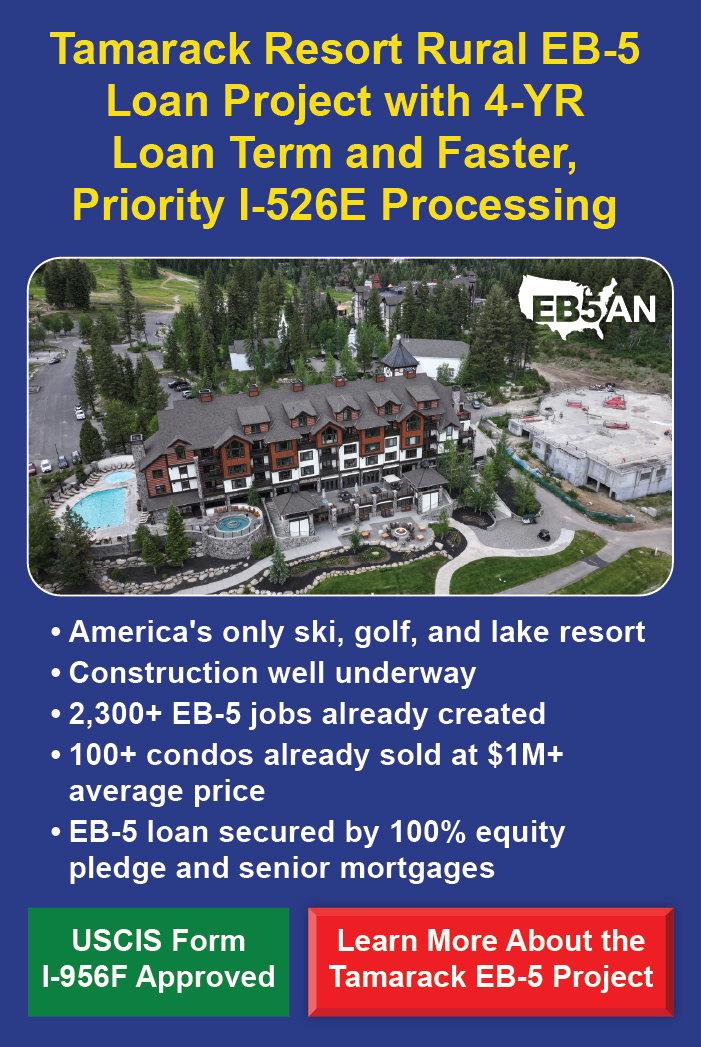The EB-5 Immigrant Investor Program—also known as the employment-based fifth-preference visa program—enables foreign nationals to obtain Green Cards by investing in the U.S. economy. It also provides a first step to gaining U.S. citizenship.
Congress created this program to stimulate the U.S. economy by using foreign capital to create jobs. The program also helps developers by offering them financing in industries like real estate.
However, there are a number of steps that investors must take and EB5 visa requirements they must meet to qualify for permanent resident status under the EB-5 program. This article explains what the main steps are.
Step One: Invest
- Invest in an NCE or Troubled Business
- Invest the Correct Amount
- Choose Between a Direct or Regional Center Investment
Step Two: Apply for the EB-5 Visa
Step Three: Run Your Business
Step Four: Lift Green Card Conditions
Get Your EB-5 Visa With EB5AN
Step One: Invest

Before a foreign national applies for the EB-5 visa, they need to invest in a U.S. business. The requirements are:
- The business, in most cases, must be a new commercial enterprise (NCE).
- The foreign national must invest the correct amount.
- They must choose either a direct or regional center investment.
This section goes into detail about each of these.
Invest in an NCE or Troubled Business
To gain permanent resident status through the EB-5 visa, a foreign national usually must invest in a new commercial enterprise. An NCE is generally:
- A for-profit business created to conduct ongoing lawful commercial activity; and
- Formed after November 29, 1990.
Certain exceptions apply. For example, the commercial enterprise may be formed before November 29, 1990, if the investor substantially restructures or expands the existing business in a way that creates a new business or increases its net worth or staffing level by at least 40%.
Almost any business structure can be used for a new commercial enterprise. However, these business entities are most often organized as Limited Liability Companies (LLCs) or partnerships.
Instead of investing in a new commercial enterprise, an investor may make a qualifying investment in a troubled business. A troubled business must have existed for at least two years and lost at least 20% of its net worth during the 12 or 24 months before the investor submits their visa application.
By making this alternative investment, the investor can avoid the usual EB-5 job creation requirement that applies to a new commercial enterprise by simply preserving 10 existing jobs.
Invest the Correct Amount
Foreign investors must be sure to invest at least the minimum amount required—valued at fair market value in U.S. dollars—under the EB-5 program.
The usual minimum capital investment for the EB-5 program is $1,050,000. However, projects located in targeted employment areas (TEAs) may be eligible for a lower minimum investment of $800,000.
A targeted employment area is a rural area or a high unemployment area—that is, with an unemployment rate that is 150% of the national average. Some national infrastructure projects also count as TEA projects.
Aside from the lower capital investment amount, TEA projects also benefit from:
- Priority visa processing: United States Citizenship and Immigration Services (USCIS) will prioritize processing visa application forms for eligible rural TEA investors over those from investors in other EB-5 projects. This can be a significant advantage given that some forms can take months or even years to process.
- Set-aside visas: The U.S. Department of State allocates a specific number of visas for the EB-5 program each fiscal year. Ordinarily, each country outside of the United States can receive no more than 7% of those visas, causing lengthy delays for many applicants from high-demand countries. However, 32% of the total number of EB-5 visas are also reserved for TEA projects. By investing in a set-aside visa category, an investor can avoid getting caught in a visa backlog.
Most of EB5AN’s projects are located in targeted employment areas.
Choose Between a Direct or Regional Center Investment
EB-5 applicants can choose to invest directly in an NCE or make the investment through a regional center.
Direct Investment
As the name suggests, this is where the foreign national invests directly into a new commercial enterprise.
- Have significant control over the business they invest in.
- Achieve potentially good financial returns from their investment.
- Continue running the business once they have been granted permanent residency.
Only one EB-5 applicant can make a direct investment in an NCE at a time.
Regional Center Investment
This is where you invest money in a new commercial enterprise via a USCIS-designated regional center. Regional centers pool capital from multiple EB-5 investors, allowing them to finance larger projects that are more likely to be successful and fulfill the EB-5 program requirements on behalf of investors.
There are several other benefits to investing via a regional center:
- Relaxed job creation requirements: All EB-5 visa applicants need to generate at least 10 full-time jobs from their investment. Regional center investors can count induced and indirect jobs toward this job creation requirement. In other words, they can count jobs that were created beyond and because of the project they invested in, in addition to the direct jobs generated by the NCE.
- Faster processing of Form I-526E: Regional centers can submit exemplar I-526E petitions to USCIS. Once USCIS approves an exemplar form, the project section of all future forms is automatically approved.
- Limited management responsibility: Regional center investors do not have to get involved in the day-to-day management of the NCE or project. They only need to vote on certain decisions.
Regional center investing is perfect for those who care mainly about getting permanent resident status as soon as possible. They usually don’t want to run a business and want minimal immigration and financial risk.
Over 95% of all EB-5 visa applicants invest via a regional center.
Step Two: Apply for the EB-5 Visa

Once you have made your investment, you can apply for the EB-5 program. This involves filling out and filing multiple forms.
Form I-526 or I-526E
When applying for the EB-5 program, direct investors must submit Form I-526 and regional center investors must submit Form I-526E.
A completed Form I-526 or I-526E should include details of:
- The business you are investing in.
- Evidence that you have made the correct investment.
- A detailed business plan explaining how your investment will create 10 jobs.
- Documentation proving your managerial role in the business.
Effective April 1, 2024, the filing fee for both forms is $11,160.
80% of all I-526 forms filed by applicants who were not born in China are currently processed within 55.5 months. The figure for those born in mainland China is 88 months. Prospective investors should check official USCIS processing times for current estimates, as they tend to change over time.
Form I-485
If you apply for the EB-5 visa and you currently live in the United States, you can apply for conditional permanent residency status. This allows you to live and work in the U.S. during the EB-5 visa process.
You can now file Form I-485 at the same time as Form I-526E. This is called concurrent filing and it prevents EB-5 petitioners from being forced to leave the country while their forms are processed.
Filing Form I-485 currently costs between $750 (for those under the age of 14) and $1,225 (for those between 14 and 78 years old, including a biometric services fee). Effective April 1, 2024, the total filing fee for an adult I-485 petitioner will be $1,440.
Processing times vary depending on your local office. For example, 80% of all I-485 forms at the California Service Center are currently processed within 20.5 months.
Form DS-260
If you live outside of the United States, then you need to file Form DS-260, Immigrant Visa Electronic Application. If your application is approved, you will be granted a conditional Green Card. This will allow you to travel to the United States to work and live during the EB-5 investment process.
Step Three: Run Your Business

Once your Form I-526 has been accepted, you need to leave your investment in the business for at least two years. There are three main requirements at this stage:
- Manage the enterprise: You need to be able to prove that you were involved in managing the business. As mentioned above, regional center investors only need to vote on board decisions. Direct investors need to be more hands-on with the business.
- Keep funds at risk: The EB-5 capital must be at risk during the full two-year period. In other words, the funds cannot simply sit in a business bank account; there needs to be a chance that you could lose it all if the project were to fail. Most regional centers will take steps to minimize this risk for their investors.
- Generate 10 full-time jobs: This is the most important requirement. Each EB-5 investor must create at least 10 full-time jobs for American citizens, lawful permanent residents, or other immigrant visa holders authorized to work in the United States. As mentioned before, direct investors must employ these workers directly, whereas regional center investors can count induced and indirect jobs for up to 90% of the total number of jobs created.
Step Four: Lift Green Card Conditions

Before the two-year period is up, you should apply to have conditions on your conditional EB-5 Green Card. If your application is approved, you will have the permanent right to live and work in the United States.
File Form I-829
During the 90-day period before your conditional Green Card expires, you need to file Form I-829. This is your application to remove conditions from your Green Card.
Your Form I-829 needs to provide evidence that you have met the requirements of the EB-5 program. This includes:
- Copies of conditional Green Cards for you, your spouse, and any dependent children.
- Proof of your investment.
- Proof that your investment remained at risk for two years.
- Proof that your investment generated 10 full-time jobs.
- A criminal record for the period that you have lived in the U.S.
The filing fee for Form I-829 is $3,750 and a biometrics fee of $85. This will increase to a total of $9,525 on April 1, 2024. Currently, 80% of I-829 forms are processed within 61 months.
The permanent resident status of EB-5 investors continues for four years after Green Card expiry, as long as they have their I-829 receipt notice.
Get Your EB-5 Visa With EB5AN
The EB-5 program has enjoyed support from Congress since its inception and has created thousands of jobs for American citizens across the country, contributing to economic growth.
EB5AN has helped more than 2,300 families from 60 countries relocate to the United States as lawful permanent residents. Our expert team has more than a decade of experience, and offers clients first-rate, low-risk EB-5 regional center projects with 100% USCIS project approval rate to date.
If you are interested in gaining U.S. Green Cards for you and your family through the EB-5 visa, book a call with our EB-5 team to get all your questions answered.


.jpg)







